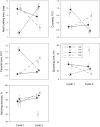The importance of considering the duration of extreme temperatures when investigating responses to climate change
- PMID: 36053986
- PMCID: PMC9805119
- DOI: 10.1111/gcb.16381
The importance of considering the duration of extreme temperatures when investigating responses to climate change
Abstract
The frequency and duration of heatwaves are increasing because of human activities. To cope with the changes, species with longer generation times may have to rely on plastic responses. The probability that their responses are adaptive is higher if the species have experienced temperature fluctuations also in their evolutionary past. However, experimental studies investigating responses to heatwaves often use exposure times that are significantly shorter than recent heatwaves. We show that this can lead to faulty conclusions and that the duration of higher temperature has to be considered in experimental designs. We recorded the response of threespine stickleback to prolonged duration of higher temperature during the breeding season, using a population that has experienced large fluctuations in temperature in its past and, hence, is expected to endure temperature changes well. We found males to adaptively adjust their reproductive behaviours to short periods of higher temperature, but not to longer periods that extended across two breeding cycles. Males initially increased their reproductive activities-nest building, courtship and parental care-which ensured high reproductive success during the first breeding cycle, but decreased their reproductive activities during the second breeding cycle when exposed to sustained high temperature. This reduced their courtship success and resulted in fewer offspring. Thus, a species expected to cope well with higher temperature suffers fitness reductions when the duration of high temperature is prolonged. The results stress the importance of considering the duration of extreme environmental conditions when investigating the impact that human activities have on species. Responses to short-term exposures cannot be extrapolated to assess responses to longer periods of extreme conditions.
Keywords: behaviour; climate change; courtship; global warming; heatwave; phenotypic plasticity; reproduction; spawning.
© 2022 The Authors. Global Change Biology published by John Wiley & Sons Ltd.
Conflict of interest statement
The authors declare no conflict of interest.
Figures

References
-
- Angiletta, M. J. (2009). Thermal adaptation: A theoretical and empirical synthesis. Oxford University Press.
-
- Antao, L. H. , Bates, A. E. , Blowes, S. A. , Waldock, C. , Supp, S. R. , Magurran, A. E. , Dornelas, M. , & Schipper, A. M. (2020). Temperature‐related biodiversity change across temperate marine and terrestrial systems. Nature Ecology and Evolution, 4(7), 927–933. 10.1038/s41559-020-1185-7 - DOI - PubMed
-
- Barrett, R. D. H. , & Hendry, A. P. (2012). Evolutionary rescue under environmental change? In Candolin U. & Wong B. B. M. (Eds.), Behavioural responses to a changing world. Mechanisms and consequences (pp. 216–233). Oxford University Press.
-
- Bay, R. A. , Rose, N. , Barrett, R. , Bernatchez, L. , Ghalambor, C. K. , Lasky, J. R. , Brem, R. B. , Palumbi, S. R. , & Ralph, P. (2017). Predicting responses to contemporary environmental change using evolutionary response architectures. American Naturalist, 189(5), 463–473. 10.1086/691233 - DOI - PubMed
Publication types
MeSH terms
LinkOut - more resources
Full Text Sources
Other Literature Sources
Medical
Miscellaneous

